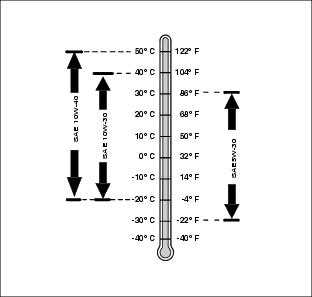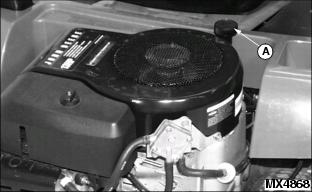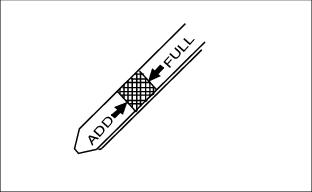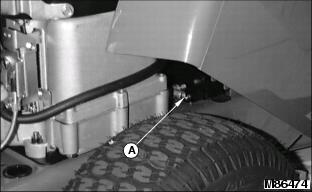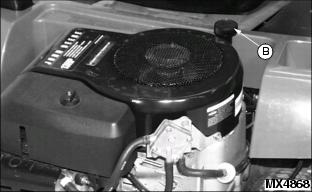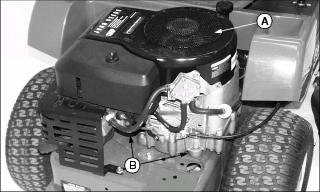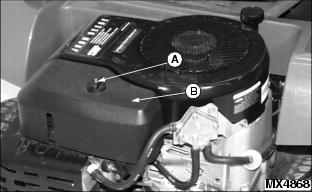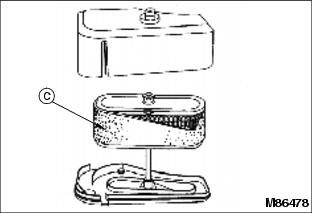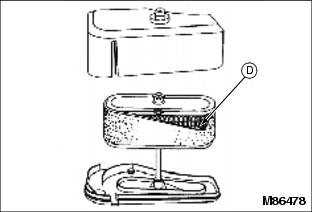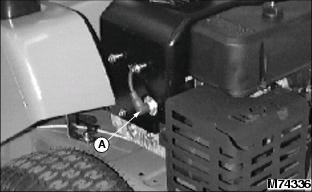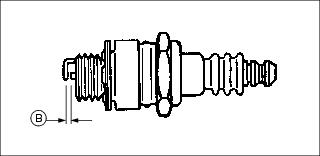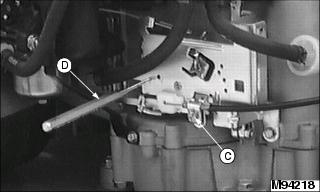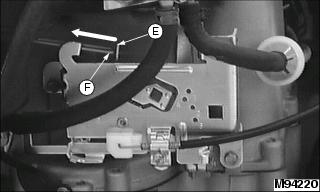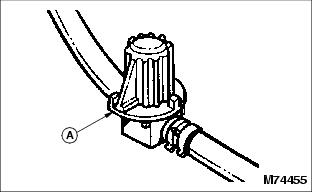Introduction
Product Identification
Safety
Operating
Replacement Parts
Service Intervals
Service Lubrication
Service Engine
Engine Warranty Maintenance Statement
Cleaning Air Intake Screen and Engine Fins
Checking and Cleaning Air Cleaner Element
Service Mower
Service Electrical
Service Miscellaneous
Troubleshooting
Storage
Assembly
Specifications
Warranty
John Deere Quality Statement
Service Record

Service Engine
Engine Warranty Maintenance Statement
Maintenance, repair, or replacement of the emission control devices and systems on this engine, which are being done at the customers expense, may be performed by any non-road engine repair establishment or individual. Warranty repairs must be performed by an authorized John Deere dealer.
Avoid Fumes
Engine Oil (Gas)
Use oil viscosity based on the expected air temperature range during the period between oil changes.
The following John Deere oils are preferred:
Other oils may be used if above John Deere oils are not available, provided they meet the following specification:
· API Service Classification SG or higher
Checking Engine Oil Level
NOTE: Check oil twice a day if you run engine over 4 hours in a day.
1. Park machine safely. (See Parking Safely in the Safety Section.)
2. Remove dipstick (A). Wipe with clean cloth.
3. Install and tighten dipstick.
5. Check oil level on dipstick.Oil must be between ADD and FULL marks.
6. If oil level is low, add oil to bring oil level no higher than FULL mark on dipstick.
7. Install and tighten dipstick.
Changing Engine Oil
2. Park machine safely. (See Parking Safely in the Safety Section.)
3. Put drain pan under drain valve.
Picture Note: Valve is located on right side.
4. Install drain hose on drain valve (A).
5. Open drain valve using an open end wrench and drain oil into oil drain pan. Allow oil to drain completely.
6. Close drain valve and tighten to 5.65 N·m (4.12 lb-ft.).
10. Install and tighten dipstick.
11. Start and run engine at idle to check for leaks. Stop engine. Fix any leaks before operating.
12. Check oil level, add oil if necessary.
Cleaning Air Intake Screen and Engine Fins
IMPORTANT: Avoid damage! The engine is air-cooled and requires a large amount of air intake when running. Reduced air intake can cause overheating: |
1. Park machine safely. (See Parking Safely in the Safety Section.)
2. Clean air intake screen (A), cooling fins and external surfaces (B), with rag, brush, vacuum or compressed air.
Checking and Cleaning Air Cleaner Element
1. Park machine safely. (See Parking Safely in the Safety Section.)
4. Clean dirt and debris from the air cleaner cover.
5. Loosen knob (A) to remove air cleaner cover (B).
6. Inspect the foam precleaner without removing it. If the foam precleaner (C) is dirty:
· Remove it from the filter carefully, leaving the paper element in the air cleaner housing.
· Wash precleaner in a solution of warm water and liquid detergent.
· Rinse precleaner thoroughly. Squeeze out excess water in a dry cloth until precleaner is completely dry.
· Put approximately 30 ml. (1 oz.) of clean engine oil onto the precleaner. Squeeze precleaner to distribute the oil evenly. Squeeze out excess oil with a clean cloth.
7. Remove and replace paper element (D) only if damaged or very dirty.
· Carefully remove the element from the air cleaner housing. Replace with a new element.
8. Clean air cleaner base very carefully, preventing any dirt from falling into carburetor.
9. Install foam precleaner onto paper element and install into air cleaner base.
10. Install air cleaner cover and tighten knob. DO NOT overtighten.
Checking Spark Plug
1. Park machine safely. (See Parking Safely in the Safety Section.)
2. Disconnect spark plug wire (A).
4. Clean spark plug carefully with a wire brush.
· Pitted or damaged electrodes.
NOTE: In Canada, replace spark plug with resistor plug only.
6. Replace spark plug if necessary.
7. Check and adjust spark plug gap (B). Gap must be 0.76 mm (0.030-in.).
8. Install and tighten spark plug. Tighten to 25 N·m (18 lb-ft.).
Adjusting Carburetor
NOTE: Carburetor is calibrated by the engine manufacturer and is not adjustable.
If engine is operated at altitudes above 1829 m (6,000 ft), some carburetors may require a special high altitude main jet. See your John Deere dealer.
If engine is hard to start or runs rough, check the troubleshooting section of this manual.
Possible engine surging will occur at high throttle with transmission in "N" neutral and mower engagement lever disengaged. This is a normal condition due to the emission control system.
After performing the checks in the troubleshooting section and your engine is still not performing correctly, contact your John Deere dealer.
Adjusting Throttle Cable
1. Park machine safely. (See Parking Safely in the Safety Section.)
2. Move throttle lever to fast position.
3. Align hole (A) in primary control plate with throttle pivot arm hole (B), hidden behind primary control plate, by moving throttle cable inside clamp and cap screw (C). Make sure holes are aligned.
4. Insert small punch (D) into aligned holes.
5. Tighten throttle cable clamp and cap screw (C).
6. Remove punch from adjustment holes.
7. Move throttle lever to choke position.
8. Check that throttle pivot arm (E) is up against choke link (F).
9. Push throttle pivot arm to the left, arm should move a maximum of 4.7 mm (3/16-in).
10. Sit in operators seat and start the engine.
11. Move throttle lever gradually out of choke position and as soon as engine starts to 1/2 throttle position. Allow engine rpm to smooth-out, then move throttle lever to fast position. Engine rpm should increase smoothly to fast idle speed.
12. Check adjustment holes alignment, if holes are aligned, adjustment is complete. If holes DO NOT align, repeat adjustment procedure.
Replacing Fuel Filter
NOTE: Change filter when fuel is low.
1. Park machine safely. (See Parking Safely in the Safety Section.)
3. Turn fuel shut-off valve (A) to closed position.
4. Put a drain pan under fuel filter.
5. Slide hose clamps (A) away from fuel filter (B) using a pliers.
6. Disconnect hoses from filter.
7. Connect hoses to new filter making sure the filter arrow is pointing in the direction of the fuel flow.

